

Money Activities & Strategies

Featured Topic: Money
Counting money involves complex number sense skills as students are usually taught to organize coins, counting from the highest value to the lowest value. This method involves counting by 25s, then switching to counting by 10s, then counting by 5s and finally counting by 1s. Think about this the next time students have problems counting money and plan to give them regular practice in these counting skills by using some of the strategies listed below that build on student number sense strengths to count coins and make change.
See Math-Literature Connections: Money for suggested books, activities and internet links.
Strategies for Teaching Money
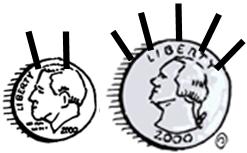
Coin antennas: Students draw antennas on coin pictures to represent the value. Each antenna is worth 5 cents. This means a dime has two antennas, a nickel has one antenna, a penny has no antennas, etc. This strategy capitalizes on students' strength in counting by fives. They simply point to each antenna as they count by 5s, then count on by ones to include any pennies. This method is also efficient because students do not need to sort and reaarange coins; they simply draw antennas on coins in the order given. This method is especially effective for K-2 regular and special ed. students who will eventually outgrow the need for antennas. NOTE: some teachers call the antennas "hairs" and talk about the penny as "bald" because it has no hair. Whatever works for you and your students is the best strategy.
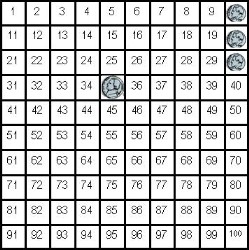
Hundred Chart: students who confidently use the hundred chart and its patterns to solve problems can utilize this tool to work with coins:
- Counting coins: Use a hundred chart to help students count coins. Have students place coins on the correct number. For instance, given 3 dimes and 1 nickel, students would place dimes on 10, 20, 30 and the nickel on 35. The last coin tells students how much money they have altogether. This method is effective for having students figure out which coins to use to pay for an item.
- Making change for a dollar: Place a counter on the price of the object. Place pennies on each square to get to the nearest multiple of 5. Use nickels, dimes or quarters to get to $1.00. Students should begin with whatever combination of coins they wish then work toward using the least number of coins as they become more proficient at making change.
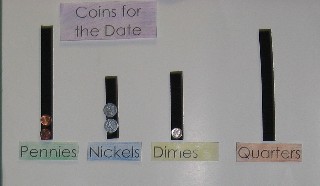
Coins for the Day: As part of morning routines, students add another penny to the coin collection from the previous day and make coin exchanges when possible. Kindergarten and first grade students can use coins to express the date. Older students can use coins to match the school day count.
- See more about Morning Math Routines which include Coins for the day.
- See Morning Math Routines: Photo Gallery for additional pictures of these daily math activities.
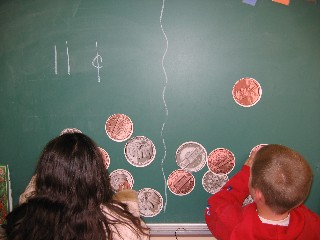
Coin Race: Mrs. Higgins and Ms. Gillespie's first graders at Port Monmouth Road School in Keansburg, NJ, use large magnetized coin cutouts to make the correct money amount. This activity provides a platform for discussing different ways to make the same amount as student pairs often choose different coin combinations. Students at their seats use coins to create combinations as well and record them on whiteboards, if desired.
Many Coins, Many Ways: challenge students to find all of the different ways to use coins to express the day's date. Students may start this challenge haphazardly, but this activity presents older students the opportunity to learn the value of using an organized approach to solving these types of problems so that they will be confident that they have found all of the possibilities. Teachers might model the use of a chart, for instance, to record combinations. Students should be prompted to talk about the orderly approaches they used.
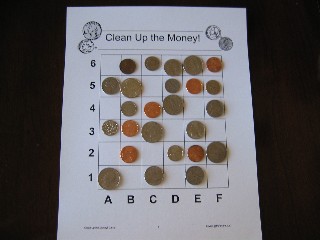
Featured Game: Clean Up the Money Game
Clean Up the Money! Game: this 2-player game challenges students to toss 2 dice, form a coordinate pair, then collect the coin from that space, if there is one. First students alternate placing quarters, dimes, nickels and pennies on the gameboard. Then students toss a regular die and a special die (A-B-C-D-E-F) to form the coordinate pair and remove the coin from the matching space. Variations of the game are given but students must always find the value of their coins to identify the winner of the game so they get plenty of practice sorting and counting coins. NOTE: Buy wooden cubes at craft stores to create the ABCDEF die or use labels to cover the faces of a regular die.
- Download
 Clean up the Money! Game for game board, directions and recording sheet for different versions of the game.
Clean up the Money! Game for game board, directions and recording sheet for different versions of the game.
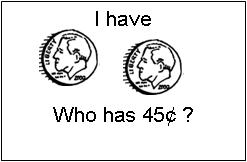
Who Has? Coin Deck: Use coin stickers, stamps or cutouts to create a Who Has? coin deck for practice in counting collections of coins.
- See
 Who Has? Coins for a suggested sequence and directions for creating a 20-card coin deck for classroom use.
Who Has? Coins for a suggested sequence and directions for creating a 20-card coin deck for classroom use.
- NOTE: Since other students cannot see the card, the student "reads" the coins aloud. The card to the right would be read: I have 2 dimes. Who has 45 cents? The next student would then answer: I have 1 quarter and 2 dimes. Who has 37 cents? and so on until the cards cycle back to the beginning card.
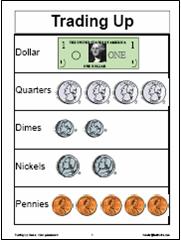
Trading Up Game: this 2-player game challenges students to toss 2 dice, calculate the sum and take that many cents from their bank. The student places these coins on his/her gameboard. The player "trades up" to higher value coins whenever possible and replaces coin collections with the larger value coin. The first player to trade up to the dollar bill wins the game.
- Download
 Trading up Game for b/w game board and directions.
Trading up Game for b/w game board and directions.
- Download
 Trading up Game for color game board that shows coin faces.
Trading up Game for color game board that shows coin faces.
Math-Literature Connections: Money
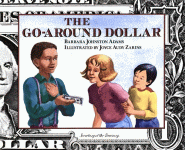
Use these books to introduce and/or reinforce money skills. The stories in these books provide real-life connections for students and motivate them to master money skills so they do not encounter the problems the characters face in these books. Book discussions and activities should focus on increasing student proficiency with money exchanges, making change and making sound fiscal decisions. Links to several online activities are included to get your creative juices flowing as you craft connections and follow-up activities for your students.
- See Math-Literature Connections: Money for suggested books, activities and internet links.
How Much Is Your Name Worth?

This is a great money activity to start the year as students get to know each other in their new classes. Use this opportunity to sneak in some data analysis skills by graphing the results in a line plot and then using statistical concepts to analyze the results.
- Students must calculate the cost of their name using the assigned letter values. Students should be allowed to use calculators for this activity. Students must then show two different ways to pay for their name.
- Differentiation: use only first names, last names, first & last names, etc. to best meet the needs of learners in each class or grade.
- Extend the activity: Make a quick line plot of the values of students' names in the class and analyze the results mathematically. Use any of these statistical concepts that your students can currently handle:
- Who has the most expensive name? [maximum value]
- Who has the least expensive name? [minimum value]
- What is the range of values in the class? [range = difference between maximum and minimum value]
- Are there students whose names have the same value? Which value, if any, do most students' names have? [mode = most common value]
- If the values are ordered from least to greatest, who has the middle value in the class? [median]
- Complete this sentence: Most students' names in this class are worth ________. Explain your answer.
- Grade level project: if several classes complete the activity and post the results, each class can compare their results to other classes to enrich the activity even more.
- Math-Literature Connection: read Chrysanthemum by Kevin Henkes and calculate the cost of characters'names. Chrysanthemum's name is the longest. Is it also the most expensive? See Math-Literature Connections: Data Analysis for additional information on this book.
- Math Center Ideas:
- Dollar words: challenge students to search for dollar words (words that cost exactly $1.00.
- See
 List of Dollar Words for teacher reference.
List of Dollar Words for teacher reference.
- Use Balmoral's
 Dollar Words to evaluate the value of different words online. The site allows students to type in any word and the program will return the cost.
Dollar Words to evaluate the value of different words online. The site allows students to type in any word and the program will return the cost.
- View a Student List of $1.00 Words that are easily recognizable and used by students.
- See
- Spelling or Literature Vocabulary words: ask students to find the cost of each word, similar to the names activity above.
- Download
 How Much Is Your Name Worth?
How Much Is Your Name Worth?
- Dollar words: challenge students to search for dollar words (words that cost exactly $1.00.
Featured Technology Links: Money
Students may use these sites to practice money skills: counting coins, calculating change, using percents to compute tips.

- Play FunBrain's
 Change Maker to practice making change for different amounts. Students may work at different levels of difficulty.
Change Maker to practice making change for different amounts. Students may work at different levels of difficulty.
- Play FunBrain's
 Penguin Waiter to practice using percents to compute the correct tip for dinner checks. Four levels of difficulty make it possible to meet the varied needs of learners in a class.
Penguin Waiter to practice using percents to compute the correct tip for dinner checks. Four levels of difficulty make it possible to meet the varied needs of learners in a class.
- In Little Finger's
 Cents Game students must count the coins shown, then enter the total value in the on-screen calculator.
Cents Game students must count the coins shown, then enter the total value in the on-screen calculator.
- The
 Practice Counting Money Game requires students to drag coins onto the table to make the correct amount. In the easy version, a "helper" totals the amount as each new coin is added for immediate feedback on independent practice.
Practice Counting Money Game requires students to drag coins onto the table to make the correct amount. In the easy version, a "helper" totals the amount as each new coin is added for immediate feedback on independent practice.
-
 Discovering Coin Values requires students to drop coins in the cup to make the correct amount of money.
Discovering Coin Values requires students to drop coins in the cup to make the correct amount of money.
- In
 Piggy Bank, coins fall and students must click on the correct coins to make the stated value before one of the columns fills to the top. Each correct solution puts money in the bank and if the student fills the bank, he/she wins the game. Easy (on-screen tab of coin values) or hard (student must keep tab of coin values) are available.
Piggy Bank, coins fall and students must click on the correct coins to make the stated value before one of the columns fills to the top. Each correct solution puts money in the bank and if the student fills the bank, he/she wins the game. Easy (on-screen tab of coin values) or hard (student must keep tab of coin values) are available.
- In
 Cash Out!, students must click on the correct coins to make change for each customer's purchase.
Cash Out!, students must click on the correct coins to make change for each customer's purchase.
- NLVM's
 Money has three different games involving coins and bills.
Money has three different games involving coins and bills.
-
 Scottie Nickel's Change Maker requires students to calculate the value of the coin collection, then deposit that same amount using the fewest number of coins.
Scottie Nickel's Change Maker requires students to calculate the value of the coin collection, then deposit that same amount using the fewest number of coins.
- The U.S. Mint's
 Making Change allows students to use tools to create their own coin with image, top and bottom text, mint, year, etc. Students may print their coins.
Making Change allows students to use tools to create their own coin with image, top and bottom text, mint, year, etc. Students may print their coins.
- Visit the U.S. Mint for additional coin facts and activities.
